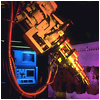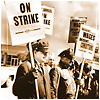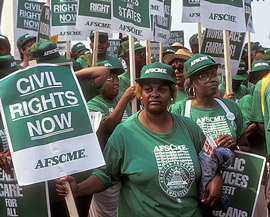
|

労働組合
- 1940年代のアメリカにおける労働組合
- 冷戦中のアメリカの労働組合
- アメリカにおける公務員労働組合
- ストライキ活動の衰退
- アメリカの労働組合組織率
- 労働権法
- 組合の種類
- アメリカ労働総同盟産別会議AFL-CIO
- アメリカにおける労働協約
- アメリカにおけるストライキ
- ストライキ中に起こること
- 長期ストライキと暴力
- 1964年公民権法
- 組合の選挙運動寄付金と政治的影響力
- 労働組合と政治
- 1990年代と今日のアメリカの労働組合
- 重要な労働組合指導者たち:ジョージ・ミーニー
- 重要な労働組合指導者たち:ジョン・L・ルイス
- 重要な労働組合指導者たち:ウォルター・ルーター
- 重要な労働組合指導者たち:A・フィリップ・ランドルフ
- 重要な労働組合指導者たち:ジミー・ホッファ
- 重要な労働組合指導者たち:セサル・チャヴェス
|

Members of the AFSCME join the AFL-CIO's "Solidarity Day" march on Washington in 1991.
Photo from Jim West.
Types of Unions in the United States
Private Unions:
In craft unions, also called horizontal unions, members share the same skill or occupation, such as the United Brotherhood of Carpenters
Industrial unions, also called vertical unions, represent workers in the same industry, regardless of their particular skill, such as the United Auto Workers. However, within the UAW workers with different skill classifications may have quite different pay levels.
Public Unions:
Public worker unions represent government employees and health care workers. The American Federation of State, County and Municipal Employees (AFSCME) is the largest public union.
In the United States today, government workers have the highest union membership rate. As a group, wholesale and retail trade workers have the lowest rate of union membership.
|
言葉の説明:
rate of union membership
|
craft union
|
industrial unions
|
| ポッドキャスト ダウンロード:
英語
| 日本語
|
|
文書 |
ビデオクリップ |
図表 |
写真 |
地図
|
|

